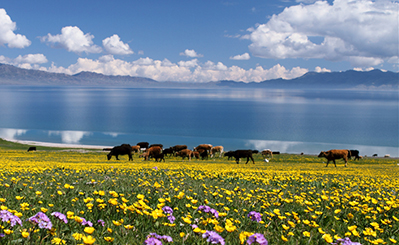Rivers and mountains home to stories of a rich past
Xinjiang Uygur autonomous region boasts a large number of lakes, rivers and other bodies of water.
The impressive Altay, Tianshan and Kunlun Mountains — three colossal ranges that showcase the region's unique geographical features — stretch across Xinjiang.
The natural treasures to be seen within this vast expanse of terrain include glaciers covering an area of 26,000 square kilometers, and comprising 42 percent of China's glacial area.
Glistening in the sunlight, these glaciers gradually melt and merge, forming a network of rivers that crisscross the land, nurturing the soil.
Amid this breathtaking natural panorama lies the Tarim River, the longest inland river in China, which weaves its way through the heart of Xinjiang. Its basin is home to green oases in an otherwise arid landscape. These oases are not merely geographical features; they are cradles of life, supporting agriculture, wildlife and, most important, nearly half of Xinjiang's population.
Meanwhile, the Ili River, with its abundant annual runoff, transforms the region into a tapestry of vibrant colors, thanks to the humid climate it sustains. This lush environment stands as one of China's vital biodiversity conservation areas, sheltering a rich variety of flora and fauna.
These ancient rivers, formed over millennia, tell stories of civilizations long past, their courses interwoven with intricate patterns of the land.
As people journey through Xinjiang's diverse landscape — from the rugged terrain sculpted by the Tianshan Mountains to the gentle curves of riverbanks — they discover the region's best-kept secrets.
Over time, human habitation has left an indelible mark, shaping not only the land but also the culture and traditions of those who call Xinjiang home.
In every whisper of the wind and ripple of the rivers, there are stories waiting to be heard — stories of resilience, adaptation and coexistence.
 Attractions
Attractions Dining
Dining Culture
Culture